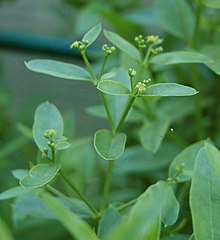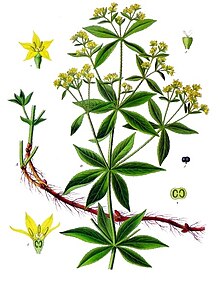Rubia tinctorum
| Rubia tinctorum | |
|---|---|

| |
| Scientific classification | |
| Kingdom: | Plantae |
| Clade: | Tracheophytes |
| Clade: | Angiosperms |
| Clade: | Eudicots |
| Clade: | Asterids |
| Order: | Gentianales |
| Family: | Rubiaceae |
| Genus: | Rubia |
| Species: | R. tinctorum
|
| Binomial name | |
| Rubia tinctorum | |
Rubia tinctorum, the rose madder or common madder or dyer's madder, is a
.Description

The common madder can grow up to 1.5 m in height. The
Uses

It has been used since ancient times as a vegetable red dye for leather, wool, cotton and silk. For dye production, the roots are harvested after two years. The outer red layer gives the common variety of the dye, the inner yellow layer the refined variety. The dye is fixed to the cloth with help of a mordant, most commonly alum. Madder can be fermented for dyeing as well (Fleurs de garance). In France, the remains were used to produce a spirit[citation needed].
The roots contain the acid
The pulverised roots can be dissolved in sulfuric acid, which leaves a dye called garance (the French name for madder) after drying. Another method of increasing the yield consisted of dissolving the roots in sulfuric acid after they had been used for dyeing. This produces a dye called garanceux. By treating the pulverized roots with alcohol, colorine was produced. It contained 40–50 times the amount of alizarin of the roots.[citation needed]
The chemical name for the
The plant's roots contain several polyphenolic compounds, such as 1,3-Dihydroxyanthraquinone (purpuroxanthin), 1,4-Dihydroxyanthraquinone (quinizarin), 1,2,4-Trihydroxyanthraquinone (purpurin) and 1,2-dihydroxyanthraquinone (alizarin). This last compound gives it its red colour to a textile dye known as Rose madder. It was also used as a colourant, especially for paint, that is referred to as madder lake. The substance was also derived from another species, Rubia cordifolia.
History
Early evidence of
Turkey red was a strong, very fast red dye for cotton obtained from madder root via a complicated multistep process involving "sumac and oak galls, calf's blood, sheep's dung, oil, soda, alum, and a solution of tin."[4] Turkey red was developed in India and spread to Turkey. Greek workers familiar with the methods of its production were brought to France in 1747, and Dutch and English spies soon discovered the secret. A sanitized version of Turkey red was being produced in Manchester by 1784, and roller-printed dress cottons with a Turkey red ground were fashionable in England by the 1820s.[5][6]
Folk medicine
According to
Risks
Madder root may cause birth defects and miscarriages in humans when taken internally.[8]
References
- Indian Journal of History of Science. 17 (11). New Delhi: Indian National Science Academy: 70–81. Archived from the original(PDF) on 2012-01-14.
- ^ Desrosiers, Sophie; Rast-Eicher, Antoinette (September 2012). "Luxurious Merovingian Textiles Excavated from Burials in the Saint Denis Basilica, France in the 6th-7th Century". Textiles and Politics: Textile Society of America 13th Biennial Symposium Proceedings: 3.
- ^ "Where did the Redcoat red dye come from?". The First Foot Guards. Retrieved 15 February 2011.
- ISBN 978-0-7207-1327-5.
- ISBN 978-0-7136-6374-7.
- ISBN 978-0-9508913-0-9.
- ^ Culpeper's Herbal: Madder at bibliomania.com
- ^ Madder, WebMD.
Further reading
- Potts, Daniel T. (2022). "On the history of madder (Rubia peregrina L., and Rubia tinctorum L.) in pre-modern Iran and the Caucasus". Asiatische Studien - Études Asiatiques. .
